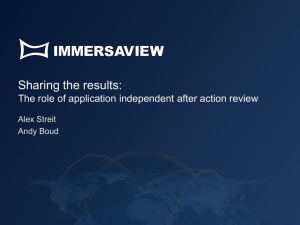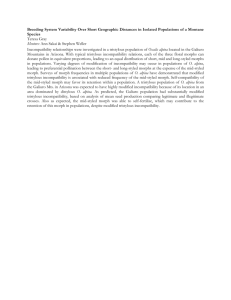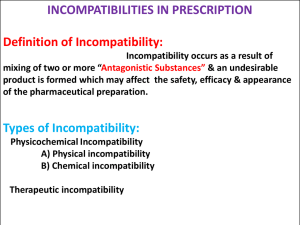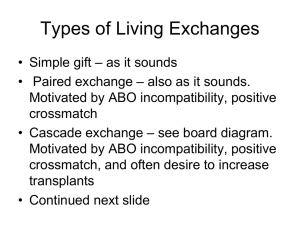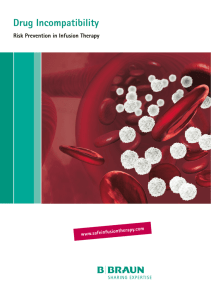IV drug compatibilities based on the pH
advertisement
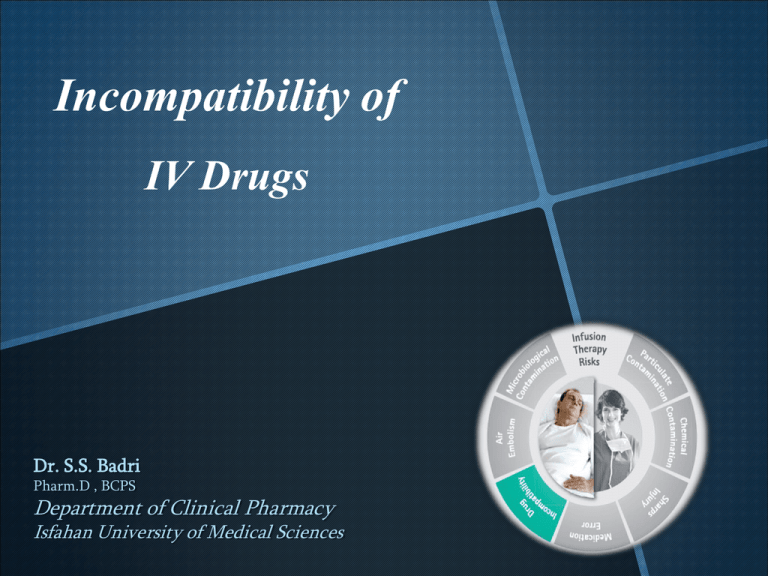
Incompatibility of IV Drugs Dr. S.S. Badri Pharm.D , BCPS Department of Clinical Pharmacy Isfahan University of Medical Sciences Types of Drug Incompatibility 1. Therapeutic incompatibility modification of the therapeutic effect of one drug by the prior concomitant administration of another (Drug interactions). 2. Physical incompatibility Interaction between two or more substances which lead to change in color, odor, taste, viscosity and morphology (pharmaceutical incompatibilities). 3. Chemical incompatibility Reaction between two or more substances which lead to change in chemical properties of pharmaceutical dosage form. Physical Incompatibility • Insolubility – Change in pH – Any change that may lead to precipitation of drugs and change in their properties. Chemical Incompatibility • Oxidation – Light → photo-chemical reactions – pH : each drug has its ideal pH for stability. Any change in pH affect drug stability and may accelerate oxidation reaction. • Physical incompatibilities result in visible (precipitate, color change, gas production) and invisible (sub-visible particles, variations in pH) reactions, and even in the absence of precipitate could result in a significant reduction in the amount of drug delivered to the patient. • Chemical incompatibilities can lead to a decrease in drug delivery, drug degradation, and/or formation of toxic products. Mixing incompatible medications • Mixing incompatible medications is a major IV medication error. • Although critically ill patients usually have multiple central IV lines, several medications have to be infused simultaneously through the same lines. • Investigations have shown that mixing an IV drug with the wrong diluents can occur in up to 80% of the cases. • This is alarming especially in the ICU where 25% of the IV incompatibilities are highly significant and 26% are life-threatening. انواع و ویژگیهای فیزیکوشیمیایی محلولهای تزریقی Glucose Na Cl K (g/L) (mEq/L) (mEq/L) (mEq/L) Normal Saline (NS) 0 154 154 0 0 308 Ringer’s Lactate (RL) 0 130 109 4 3 272 Dextrose Water, 5% (DW 5%) 50 0 0 0 0 278 DW5% in Saline (0.9%) 50 154 154 0 0 560 Half Saline (HS) 0 77 77 0 0 154 DW 3.33% + Saline 0.3% 33 51 51 0 0 270 IV Solution Ca Osmolality (mOsm/L) • Reaction of IV medications when mixed together resulting in solutions that are no longer optimal for the patient. • The stability is altered by physico-chemical reactions leading to decreased effectiveness of the drug or an increased microparticles load leading ultimately to therapeutic failure, catheter occlusion or embolism. When the dilution or mixing of the salt or ionized forms of organic drugs results in precipitation, the most likely cause is formation of the non-ionized drug forms. when ceftriaxone sodium is diluted in lactated Ringer's injection, precipitation can occur despite the alkaline pH of lactated Ringer's maintaining the ionized water-soluble form of ceftriaxone. The problem in this case is the formation of a poorly soluble calcium salt of ceftriaxone, the ionized form of which is a divalent anion. IV drug compatibilities based on the pH The pH of solution was one of the compatibility measure used in the establishment of standard concentrations of medications commonly given by continuous infusion and prepared at the bedside. Vilma Loubnan, Soumana C Nasser. [Lebanese American University, Beirut, Lebanon] A Guide on Intravenous Drug Compatibilities Based on Their pH. International Journal of Comprehensive Pharmacy (IJCP) 2010; 1(5): 1-9. Medications admixture into a solution could alter the pH to acidic or basic depending on the solution buffer capacity. • Normal Saline (NS) and Dextrose 5% in water (D5W) solutions have low buffer capacity, so that the solution will turn acidic with the admixture of an acidic medication, and it will turn basic with the admixture of a basic medication. • Lactated Ringer’s (LR) solution has a high buffer capacity, so that when adding an acidic medication, the solution will either remain neutral or the pH will drop to a lesser extent than that observed with NS or D5W solution. Furosemide-Midazolam incompatibility • • • Even in the absence of visible particles, precipitation of furosemide led to a drug loss estimated at between 10 % and 15 %. Furosemide is more impacted by interaction because the pH of the mixture is acid and this form is poorly soluble in an aqueous solution. Physical incompatibility between furosemide and midazolam leads to a significant reduction in drug delivered to the patient and may result in treatment failure.


